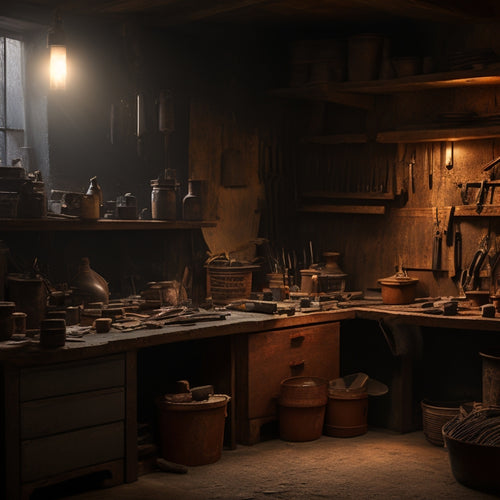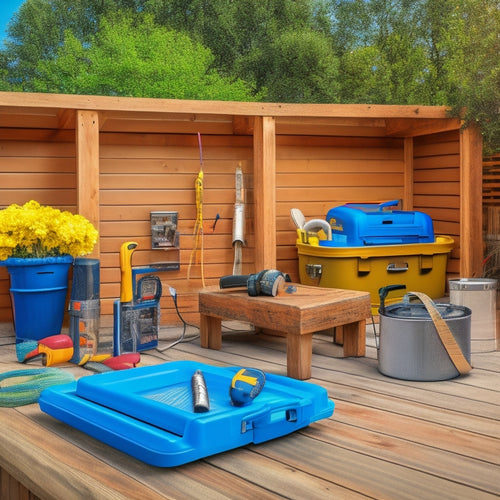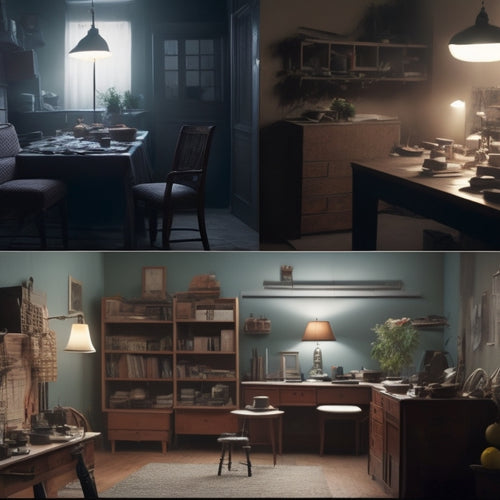
Pointing Tool Checklist for Home Renovations
Share
As you prepare for your home renovation's brick pointing phase, confirm you have the essential tools, including trowels, joint rakes, and a pointing trowel and finishing tool. Don't forget vital safety gear like protective eyewear, durable gloves, and a dust mask or respirator. Next, focus on mixing and applying mortar, removing old debris, and cleaning and preparing joints. Then, move on to tuck pointing and finishing, and finally, inspect and maintain your walls to prevent future issues. With this checklist, you'll be well-equipped to tackle the project; now, delve into the details to guarantee a successful and long-lasting outcome.
Key Takeaways
• Ensure you have essential tools like trowels, joint rakes, and pointing trowels to complete the pointing process efficiently.
• Wear necessary safety gear, including protective eyewear, gloves, and a dust mask, to prevent injuries and exposure to hazardous materials.
• Master various techniques for mixing and applying mortar, including accurate mixing ratios, ideal temperature ranges, and regular cleanup.
• Remove old mortar debris using appropriate methods, such as sweep and shovel, dustless vacuum, or hand tools, and dispose of it properly.
• Inspect and maintain walls regularly to address signs of wear, damage, or deterioration, and ensure proper drainage and ventilation to prevent moisture issues.
Essential Tools for Brick Pointing
When tackling a brick pointing project, you'll need to assemble a set of essential tools to guarantee professional-looking results and efficient workflow. Don't bother showing up to the job site without these must-haves!
First, you'll need a variety of trowels to handle different brick types, from soft and porous to hard and dense.
Next, grab your joint rakes, which come in various widths to accommodate different mortar joints.
Speaking of mortar, you'll want to select a color that complements your brick choice – don't worry, there are plenty of mortar colors to choose from!
A level and straightedge will make sure your pointing is, well, straight and level.
A hawk or mortar board will keep your mortar fresh and within reach.
Finally, a pointing trowel and finishing tool will help you achieve a smooth, professional finish.
With these tools in your arsenal, you'll be well on your way to a beautifully pointed brick façade that'll make the neighbors jealous!
Safety Gear for Protection
You'll need to prioritize your personal safety by wearing essential gear to protect yourself from the hazards associated with brick pointing, including airborne silica dust, falling debris, and sharp tools.
Don't become a DIY disaster story – invest in the right safety gear to avoid common injuries.
First, grab some protective eyewear that meets ANSI standards – you don't want silica dust or debris flying into your peepers.
Next, slip on some durable gloves that provide grip, protection, and dexterity. You'll be handling heavy tools and rough materials, so your hands need to be shielded from cuts, abrasions, and blisters.
A dust mask or respirator is also a must-have to prevent inhaling hazardous particles.
Don't forget sturdy footwear with good traction to prevent slips and falls.
Finally, consider a hard hat or safety helmet to protect your noggin from falling objects.
Mixing and Applying Mortar
When you're mixing and applying mortar, you'll need to get the ratios just right, as improper mixes can compromise the structural integrity of your renovation.
You'll also need to master various application techniques, such as buttering or scratch-coating, to guarantee a strong bond between the mortar and the surrounding material.
Mixing Ratios Matter
Accurate mixing ratios are vital to achieving a strong, durable bond between mortar and masonry units, as even slight deviations can compromise the structural integrity of your renovation project. You don't want your hard work to crumble (literally!) due to a simple mistake.
When it comes to mixing mortar, you'll need to take into account the type of mortar you're working with. Different mortar types, such as Type S, Type N, or epoxy-based mortars, require specific mixing ratios. Don't assume one-size-fits-all – it's important to follow the manufacturer's instructions.
Temperature also plays a significant role in mortar mixing. Extreme temperatures can affect the workability and strength of the mortar, so make certain to mix and apply it within the recommended temperature range. A general rule of thumb is to mix mortar when the temperature is between 40°F and 90°F (4°C and 32°C).
Application Techniques Vary
Proper application techniques are essential to achieving a strong, durable bond between mortar and masonry units, as inconsistent or sloppy application can lead to compromised structural integrity. You wouldn't want your renovation project to come crumbling down, literally! As you begin applying mortar, remember that different joint types require distinct application techniques.
| Joint Type | Application Technique |
|---|---|
| Concave Joint | Hold the pointing trowel at a 45-degree angle, pressing the mortar firmly into the joint. |
| V-Joint | Use a V-notched trowel to fill the joint, then smooth it out with a pointing trowel. |
| Grapevine Joint | Apply mortar in a serpentine motion, using a pointing trowel to fill the joint. |
| Struck Joint | Fill the joint with mortar, then use a pointing trowel to strike off excess material. |
Cleanup Is Essential
You must prioritize cleanup as you mix and apply mortar to prevent hardened residue from ruining your tools and masonry surfaces.
It's easy to get caught up in the excitement of renovation, but neglecting cleanup can lead to costly mistakes and future headaches. Develop a solid cleanup strategy to avoid the dreaded 'mortar mess.'
As you work, regularly wipe your tools with a damp cloth to prevent mortar from drying on the surface. This will save you from having to scrub away at hardened residue later.
Keep a bucket of water and a stiff brush nearby to quickly clean up spills and splatters. For tougher messes, mix baking soda and water to create a paste that can help break down dried mortar.
Don't forget to clean your mixing area and wash your hands thoroughly to avoid tracking mortar throughout your home.
Removing Old Mortar Debris
When removing old mortar debris, you'll need to decide on the best method for your specific job, considering factors like the type of mortar, the condition of the surrounding masonry, and the level of precision required.
You'll also need to choose the right tools for mortar chip extraction, taking care to avoid damaging the underlying structure.
Debris Removal Methods
This essential step involves efficiently clearing away old mortar debris to create a clean slate for new construction, ensuring a strong foundation for your renovation project.
You don't want any leftover mortar mess ruining your new build, do you? Removing debris is important, and you've got a few options to get it done.
Here are some effective debris removal methods to keep in mind:
-
Sweep and shovel: The classic combo for clearing large chunks of debris from the area.
-
Dustless vacuum: A game-changer for indoor projects, capturing 99.97% of dust and debris particles.
-
Debris disposal services: Let the pros handle it, especially for large-scale projects.
-
Recycling materials: Get eco-friendly and recycle that debris into new materials, reducing waste and your carbon footprint.
-
Hand tools: For smaller areas, trusty hand tools like trowels and scrapers can get the job done.
Mortar Chip Extraction
Now that the area is clear of large debris, it's time to tackle the finer details, like mortar chip extraction, which involves removing old mortar debris that's often stubbornly stuck to the surface.
You'll need to choose the right extraction technique based on the type of mortar you're dealing with. For example, lime-based mortars tend to be softer and more brittle, making them easier to remove, while cement-based mortars are harder and more stubborn.
You'll want to use a combination of manual and mechanical extraction techniques to get the job done. Manual techniques include scraping and chiseling, while mechanical techniques involve using specialized tools like grinders, sanders, and wire brushes.
Be careful not to damage the surrounding surface, as this can lead to costly repairs down the line. Remember to always wear protective gear, including gloves, safety glasses, and a dust mask, to avoid injury and exposure to hazardous materials.
Dust Containment Strategies
You must develop and implement effective dust containment strategies to prevent the dispersal of hazardous particles and debris during the removal of old mortar. It's crucial to contain the mess to avoid inhaling harmful particles and prevent damage to surrounding areas. Don't let the dust devils win!
Here are some critical strategies to include in your dust containment plan:
-
Seal off the work area with dust barriers, like plastic sheets or tarps, to prevent particles from spreading to other rooms.
-
Use air filtration systems or HEPA-filter equipped vacuums to capture 99.97% of particles as small as 0.3 microns.
-
Wear personal protective equipment (PPE) like respirators, safety goggles, and gloves to shield yourself from the dust storm.
-
Dampen the area with a water mist to reduce airborne particles and make cleanup easier.
-
Designate a 'clean zone' for tools and materials to prevent cross-contamination.
Cleaning and Preparing Joints
Before applying any pointing compound, scrape away old mortar and debris from the joints using a wire brush or joint cleaner to secure a clean, solid bond.
You don't want any weak links in your joint sealing game, right? Remove any loose material, and get ready for some serious surface preparation. This step is essential, so don't rush it. Take your time to confirm the joints are spotless, as any remaining debris can compromise the new pointing compound's adhesion.
Next, use a damp cloth or sponge to wipe away any remaining dust and dirt. You're getting close to achieving those smooth, professional-looking joints! A clean joint is a happy joint, after all.
Now, inspect the joints for any cracks or gaps that need filling. If you find any, use a patching compound to fill them in. Once that's dry, you're ready to move on to the next step.
Tuck Pointing and Finishing
With the joints clean and prepared, it's time to fill them with a fresh layer of pointing compound, carefully matching the original color and texture to guarantee a seamless blend. This is where the magic of tuck pointing happens, and you get to reap the benefits of a restored, waterproof, and visually appealing wall.
Now, it's crucial to master the finishing techniques to guarantee a professional-looking result. Here are some expert tips to keep in mind:
-
Use a pointing trowel to fill the joints, holding it at a 45-degree angle to pack the compound tightly.
-
Use a damp cloth or brush to remove excess compound from the surface, avoiding smudging or smearing.
-
For a smooth finish, use a steel trowel or a specialized finishing tool to compress and level the compound.
-
Apply a second coat if necessary, allowing the first coat to set before reapplying.
-
Finally, use a clean, dry cloth to remove any haze or residue, revealing a beautifully restored wall that's sure to impress.
Inspecting and Maintaining Walls
Regularly scan your walls for signs of wear, damage, or deterioration, catching potential issues early to prevent costly repairs down the line. You don't want to be stuck with a wall that's on the verge of collapse, do you?
As you inspect, keep an eye out for cracks, crumbling mortar, or water damage. These red flags can indicate compromised wall stability, which is a major no-no.
To maintain your walls, make certain to address any issues promptly. For instance, if you notice moisture seeping through the walls, take action ASAP.
Moisture prevention is key to avoiding structural damage and pesky mold growth. Check your walls for gaps or holes and seal them up tight. Also, guarantee proper drainage and ventilation to keep your walls dry and happy.
Frequently Asked Questions
Can I Reuse Old Mortar for Pointing Brick Joints?
Can you reuse old mortar for pointing brick joints? Don't count on it!
Old mortar's composition has likely broken down, compromising joint durability. You'll end up with weak, crumbling joints that'll need redoing sooner rather than later.
Instead, mix fresh mortar that's specifically designed for pointing, and make certain it's compatible with your brick type.
Trust us, it's worth the extra effort for a job that'll last.
How Do I Prevent Mortar From Staining New Bricks?
Think of mortar like a clumsy dance partner - it can leave unsightly stains on your new bricks if you're not careful.
To prevent this, you'll want to master the art of controlled mortar application techniques. Try using a pointing trowel to contain the mortar, and avoid over-saturating the joints.
After application, quickly clean excess mortar with a damp brush or cloth.
Finally, follow up with brick cleaning methods like acid washing or sandblasting to remove any stubborn stains.
With practice, you'll be the lead dancer in the mortar-brick waltz!
Are There Any Eco-Friendly Mortar Mix Alternatives?
You're on a roll, going green with your renovation!
When it comes to eco-friendly mortar mix alternatives, you're in luck. You can opt for sustainable materials like lime-based mortars, which are gentler on the environment.
Natural binders like hemp, straw, or even coffee grounds can also replace traditional cement.
These alternatives not only reduce your carbon footprint but also add a unique touch to your project.
What Is the Best Way to Dispose of Old Mortar Debris?
As you stand amidst the rubble, surrounded by the remnants of your renovation, you're faced with an intimidating task: what to do with all that old mortar debris.
Don't let it pile up! Instead, explore mortar disposal methods that don't harm the environment.
Look into debris recycling options, like repurposing it as aggregate or sending it to a facility that'll turn it into new construction materials.
You'll be doing the planet a solid, and your conscience will thank you.
Can I Point Brick Joints in Cold or Wet Weather?
Can you point brick joints in cold or wet weather?
Sorry to be the party pooper, but you shouldn't. Pointing techniques require ideal conditions for success.
When it's chilly or rainy, the mortar won't set properly, leading to a weak joint.
Weather considerations are key - aim for temps between 40°F and 90°F, and avoid rainy days.
You want a strong, long-lasting joint, not a soggy mess.
Conclusion
As you stand back to admire your handiwork, remember that a well-pointed brick wall is like a strong foundation - it's the unsung hero that holds everything together.
Just as Atlas held up the heavens, your meticulous attention to detail has shouldered the weight of a successful renovation.
With this checklist, you've guaranteed that your walls will stand the test of time, a proof of the power of precision and dedication.
Related Posts
-

Why Invest in Quality Plastering Tools for Renovation
When renovating, investing in quality plastering tools is essential for achieving professional-looking results and mi...
-

Protect Your Tools for Outdoor Renovation Success
To guarantee outdoor renovation success, you need to protect your tool investment by understanding warranty and suppo...
-

3 Best DIY Home Renovation Timelines for Success
As you tackle your DIY home renovation project, create a solid timeline by breaking it down into three phases. First,...


